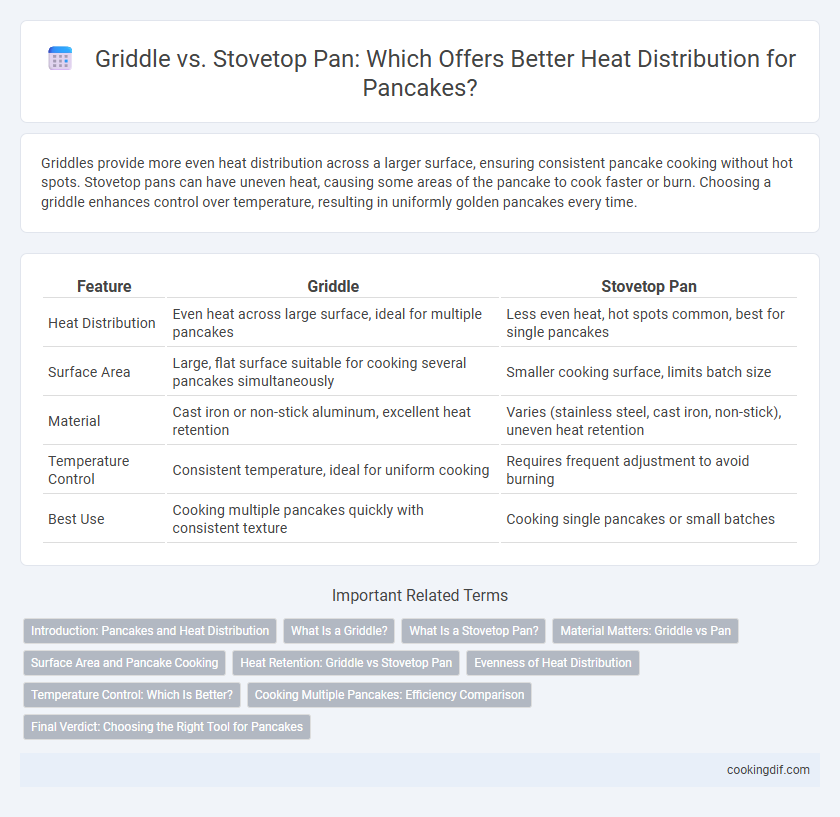Griddles provide more even heat distribution across a larger surface, ensuring consistent pancake cooking without hot spots. Stovetop pans can have uneven heat, causing some areas of the pancake to cook faster or burn. Choosing a griddle enhances control over temperature, resulting in uniformly golden pancakes every time.
Table of Comparison
| Feature | Griddle | Stovetop Pan |
|---|---|---|
| Heat Distribution | Even heat across large surface, ideal for multiple pancakes | Less even heat, hot spots common, best for single pancakes |
| Surface Area | Large, flat surface suitable for cooking several pancakes simultaneously | Smaller cooking surface, limits batch size |
| Material | Cast iron or non-stick aluminum, excellent heat retention | Varies (stainless steel, cast iron, non-stick), uneven heat retention |
| Temperature Control | Consistent temperature, ideal for uniform cooking | Requires frequent adjustment to avoid burning |
| Best Use | Cooking multiple pancakes quickly with consistent texture | Cooking single pancakes or small batches |
Introduction: Pancakes and Heat Distribution
Griddles provide even heat distribution crucial for perfectly cooked pancakes, minimizing hot spots that can cause uneven browning. Stovetop pans often have variable heat zones, which may require frequent adjustment to avoid burning or undercooking. Consistent heat from a quality griddle enhances pancake texture and color, ensuring uniform golden-brown results.
What Is a Griddle?
A griddle is a flat cooking surface typically made of cast iron, stainless steel, or aluminum, designed for even heat distribution and consistent cooking temperatures, ideal for pancakes. Unlike stovetop pans, griddles offer a larger cooking area, allowing multiple pancakes to cook simultaneously with minimal hot spots. The thick, smooth surface retains heat efficiently, promoting uniform browning and preventing uneven cooking often encountered with thinner stovetop pans.
What Is a Stovetop Pan?
A stovetop pan is a versatile cooking vessel designed to be used directly on a burner, providing even heat distribution essential for cooking pancakes uniformly. Unlike griddles, stovetop pans often feature raised edges that help contain batter and prevent spills while maintaining consistent temperature across the surface. This controlled heat retention ensures pancakes cook thoroughly without burning or undercooking, making stovetop pans an effective choice for breakfast staples.
Material Matters: Griddle vs Pan
Cast iron griddles provide superior heat retention and even distribution compared to most stovetop pans, making them ideal for achieving perfectly cooked pancakes with a consistent golden-brown crust. Aluminum pans heat up quickly but often result in hot spots that can cause uneven cooking, whereas stainless steel pans offer durability but may require additional oil to prevent sticking and ensure smooth flipping. Choosing the right material significantly impacts temperature control and pancake texture, favoring griddles for precise heat management and stovetop pans for versatility.
Surface Area and Pancake Cooking
Griddles provide a larger, flat surface area that allows multiple pancakes to cook evenly at once due to consistent heat distribution, reducing hot spots that can cause uneven cooking. Stovetop pans typically have a smaller surface area and may develop temperature variances, which can result in pancakes cooking unevenly or requiring batch cooking. The even heating and expansive surface of griddles optimize pancake cooking efficiency and quality by producing uniform color and texture across all pancakes.
Heat Retention: Griddle vs Stovetop Pan
Griddles generally offer superior heat retention compared to stovetop pans due to their larger surface area and thicker construction, which enables even cooking and consistent temperature maintenance. Cast iron griddles excel in holding heat, reducing temperature fluctuations essential for perfectly cooked pancakes. In contrast, stovetop pans, especially thinner models, tend to lose heat quickly, causing uneven cooking and frequent adjustments to maintain optimal batter cooking conditions.
Evenness of Heat Distribution
Griddles provide superior evenness of heat distribution due to their larger surface area and thicker construction, allowing pancakes to cook uniformly without hot spots. Stovetop pans often have thinner bases that can cause uneven heating, resulting in inconsistent browning and texture. For perfectly cooked pancakes, a high-quality griddle ensures consistent temperature across the entire cooking surface.
Temperature Control: Which Is Better?
Griddles generally offer superior temperature control compared to stovetop pans due to their larger, flat surface that distributes heat evenly, minimizing hot spots and ensuring consistent cooking of pancakes. Stovetop pans can develop uneven heat distribution as the heat source is concentrated in a smaller area, requiring frequent adjustments to maintain the ideal cooking temperature. For precise temperature control and consistent pancake texture, a griddle is often the preferred choice among chefs and cooking enthusiasts.
Cooking Multiple Pancakes: Efficiency Comparison
Griddles provide superior heat distribution compared to stovetop pans, allowing for consistent cooking across a larger surface area ideal for making multiple pancakes simultaneously. This even heat reduces hot spots, preventing uneven cooking and ensuring pancakes brown uniformly. Stovetop pans often have limited surface area and less consistent heating, making them less efficient for batch cooking pancakes.
Final Verdict: Choosing the Right Tool for Pancakes
Griddles provide superior heat distribution with a larger, flat surface ideal for evenly cooked pancakes, reducing the risk of hot spots and uneven browning. Stovetop pans, while more versatile, often have smaller surfaces and may require frequent temperature adjustments to maintain consistent heat. For perfectly golden, fluffy pancakes, a griddle offers the best control and uniform cooking results.
Griddle vs stovetop pan for heat distribution Infographic

 cookingdif.com
cookingdif.com